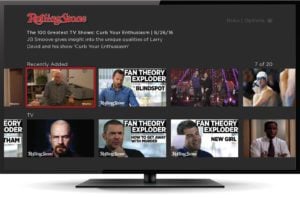 At 10 million active accounts strong, Roku is turning to media companies to improve the quality of its streams and ramp up ad monetization.
At 10 million active accounts strong, Roku is turning to media companies to improve the quality of its streams and ramp up ad monetization.
Wednesday’s rollout of Roku Direct Publisher allows content owners like Rolling Stone, UPROXX and the Scripps-owned satirical publisher Cracked to develop and distribute video via Roku apps. The tool is also designed to help increase awareness and usage of those apps.
At its most basic, Roku Direct Publisher allows a publisher to launch a streaming channel without developing new code.
Since a number of publishers use third-party video players (Brightcove, JW Player or Ooyala, for example) for streaming content across their owned-and-operated properties and the open web, Roku is also adding support for those players.
On the monetization side, Roku will offer to sell video ads on publishers’ behalf through a 60-40 revenue share, where publishers take 60% of the cut.
“That tends to be a really attractive option for mid- and long-tail publishers, but also larger publishers who may need help clearing unsold inventory or audience,” said Scott Rosenberg, VP of advertising and audience development for Roku.
Roku says it has also improved search and discovery within its operating system, which Rosenberg hopes will assist publishers with audience growth.
“A part of my team is focused exclusively on audience development – helping publishers get and keep their audiences on Roku,” Rosenberg said. “Publishers that use Roku Direct Publisher are automatically indexed in our universal search.”
Roku’s differentiating universal search feature helps more obscure Roku apps attract viewers who may not be aware of them.
And Roku can use deep linking to promote a publisher’s channels and content from display banners on its home screen or even within a video stream.
About half of Roku’s top 250 channels are now ad-supported, its fastest-growing segment in terms of both the number of apps submitted and the total number of unique users who have installed those apps.
 About 30% of over-the-top ads now flow through the Roku platform, which is more than Apple, Chromecast and Amazon Fire TV, according to FreeWheel’s latest video monetization report.
About 30% of over-the-top ads now flow through the Roku platform, which is more than Apple, Chromecast and Amazon Fire TV, according to FreeWheel’s latest video monetization report.
Of course, Roku does not get a slice of most of that revenue, but it’s gradually laying the groundwork for a larger paid media business, and building out the publisher presence on its TV OS is part of the strategy.
“In the last year, we’ve seen an evolution in how sophisticated publishers are thinking about audience acquisition and retention,” Rosenberg said. “They’re asking, ‘What were my installs last week?’, ‘How successful was I at getting someone to try my SVOD service?’, ‘How successful was I bringing someone back a second or third time?’”













